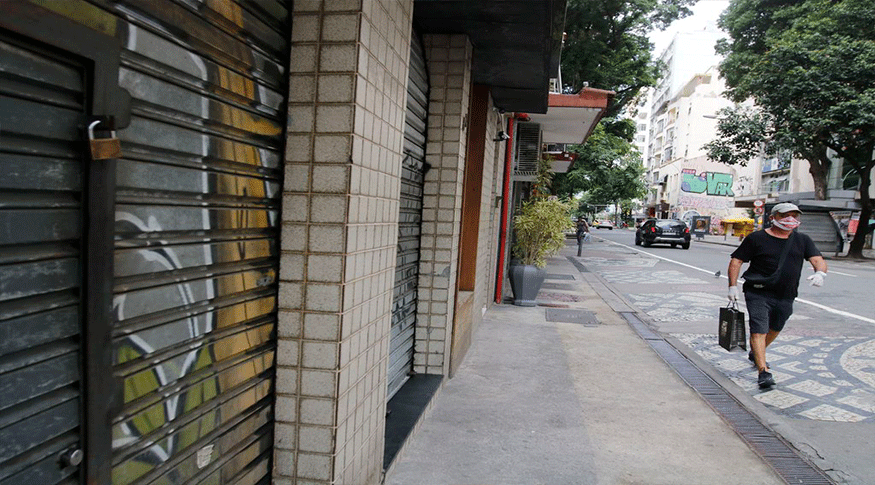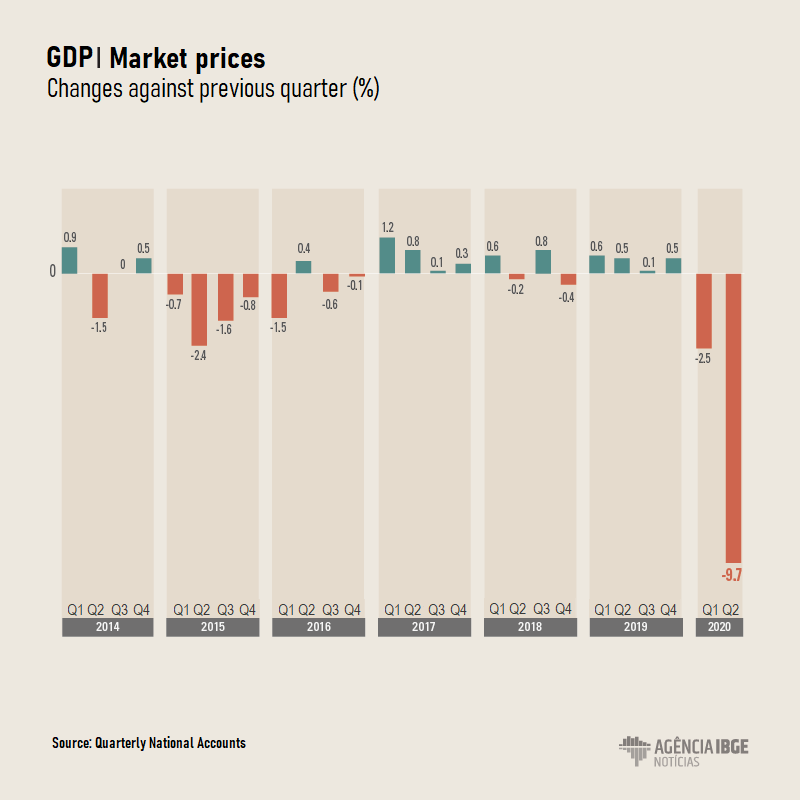National Accounts
GDP has record drop of 9.7% in Q2, peak of social distancing
September 01, 2020 09h00 AM | Last Updated: September 03, 2020 03h17 PM

The Brazilian Gross Domestic Product - GDP shrank 9.7% in the second quarter of 2020, compared with the previous quarter, peak of social distancing adopted to control the Covid-19 pandemic. According to the System of Quarterly National Accounts released today (September 1st) by the IBGE, this was the second consecutive quarterly drop and the lowest result for the economy since the beginning of the time series in 1996.
At current values, the GDP, which is the sum of the goods and services produced in Brazil, added up to R$1.653 trillion between April and June. After the revision of the drop in the first quarter from -1.5% to -2.5%, the economy accrued a drop of 5.9% in the first semester of the year. In the last four quarters, the GDP shrank 2.2% and, in the comparison with the second quarter last year, the retreat was of 11.4%. The GDP is at the same level as it was in the end of 2009, peak of the impact of the global downturn caused by the bankruptcies in the American economy.
The retraction of the economy was the result of historical drops of 12.3% in industry and of 9.7% in services. Together, industry and services represent 95% of the national GDP. On the other hand, agriculture increased 0.4%, mainly leveraged by the output of soybeans and coffee.
"These results are related to the peak of social distancing, when a number of economic activities were either partially or entirely paralyzed to fight against the pandemic," explained Rebeca Palis, IBGE´s coordinator of National Accounts.

In industry, the retreat was due to the drops of 17.5% in the manufacturing industries, of 5.7% in construction, of 4.4% in the activity of electricity and gas, water, sewage and waste management activities and of 1.1% in the mining and quarrying industries.
"In services, the biggest drop was in other services activities (-19.8%), which includes services rendered to families. Transportation, storage and mailing (-19.3%) and trade (-13.0%), which are related to the manufacturing industry, also dropped. Other retreats came from administration, defense, public health and education, and social security (-7.6%) and information and communication (-3.0%)," added the coordinator.
The only positive results were recorded by financial activities, insurance and related services (0.8%) and real estate activities (0.5%).
Household consumption has record drop of 12.5%
On the demand side, the biggest drop was in the household consumption (-12.5%), which represents 65% of the GDP. "Household consumption did not drop more because of the financial support programs from the government. It injected liquidity in the economy. Credit for natural persons also rose, which slightly offset the negative effects," said Rebeca Palis.
Government consumption declined 8.8% in the second quarter, particularly due to the drops in public health and education, explains the IBGE´s coordinator. "In health, the expenditures were more focused on the fight against Covid-19. Also, people feared to look for other services, like consultations and examinations, during the pandemic. In education, we used the percentage of the Ministry of Education of the students who attended classes or not. It also caused the government consumption to drop a lot," detailed the coordinator, highlighting that the result is not related to the fiscal policy.
The investments (Gross Fixed Capital Formation) also retreated 15.4%, due to the drop in construction and domestic production of capital goods. Only imports of capital goods increased in the period.
The goods and services account registered a rise of 1.8% in the exports, whereas the imports declined 13.2%. "Such rise in the exports has much to do with commodities, food products and petroleum. In contrast, the imports fell in several sectors, of vehicles, the entire services, travel, since everything halted due to the pandemic," said the coordinator of National Accounts.
In the cumulative indicator of the first semester, the GDP fell 5.9% in relation to the same period of 2019, with a positive performance of agriculture (1.6%). In industry (-6.5%) and services (-5.9%) the results were negative. "This was the first negative six-monthly rate since 2017, when we were leaving the economic downturn that occurred between 2015 and 2016. Now we are facing a new drop in the GDP," concludes Rebeca Palis.




















